Therapeutic Itinerary of Teenagers and Young Adults with Osteossarcoma
DOI:
https://doi.org/10.32635/2176-9745.RBC.2012v58n2.620Keywords:
Osteosarcoma, Self Care, Health Services Accessibility, Adolescent, Young Adult, Epidemiology, DescriptiveAbstract
Introduction: Late arrival to specialized medical centers of patients with osteosarcoma is related to several factors. Objective: To verify the therapeutic itinerary of patients with osteosarcoma from the outset of disease symptoms up to the moment when they are serviced at a specialized care center. The theoretical reference used was the KleinmanHealth Care Model that includes professional, family and popular components. Method: A descriptive, mixed approach study, performed at the Pediatric Oncology Institute (IOP), in São Paulo, Brazil. Results: Sixteen patients were included in the study, seven of whom were women (43.75%) and nine were men (56.25%). Their age ranged from 12 to 23 years. One or more of the following manifestations led to search for help or medical care in 43.75% of patients: pain, edema and walking limitation. The patient’s family system was the first source of help prompted in all cases. After that, half of the patients, eight of them, along with their families, looked for a health care institution. The other eight patients (50%) took care of themselves. The mean time between clinical manifestation and admission for health care was six months. Conclusion: We observed a strong influence of the patient’s family system on the decision making process for the choice of a therapeutic itinerary in this study. Nevertheless, there were different levels of failure in the health care system which led to significant delay in diagnosis.









